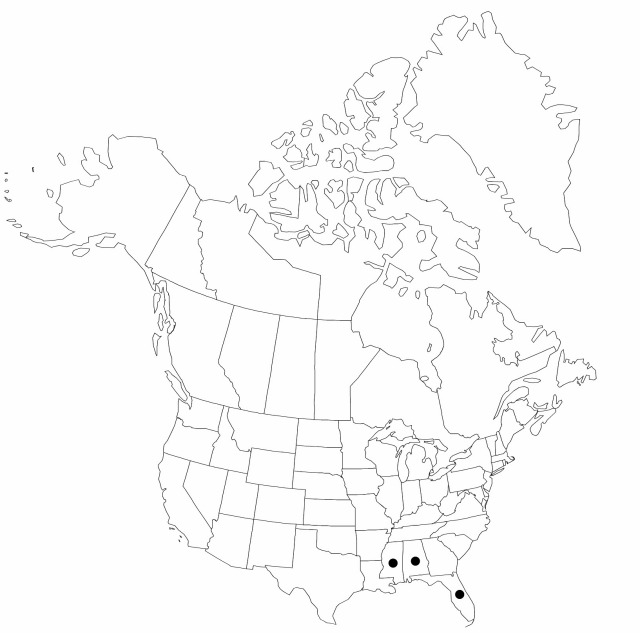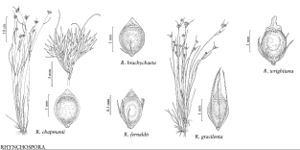Difference between revisions of "Rhynchospora brachychaeta"
Anales Real Acad. Ci. Méd. Fís. Nat. Habana 8: 85. 1873.
FNA>Volume Importer |
FNA>Volume Importer |
||
| Line 10: | Line 10: | ||
|name=Rhynchospora chapmanii | |name=Rhynchospora chapmanii | ||
|authority=Britton | |authority=Britton | ||
| − | }}{{Treatment/ID/Synonym | + | }} {{Treatment/ID/Synonym |
|name=Rhynchospora pallida | |name=Rhynchospora pallida | ||
|authority=C. B. Clarke | |authority=C. B. Clarke | ||
| − | }}{{Treatment/ID/Synonym | + | }} {{Treatment/ID/Synonym |
|name=Rhynchospora pallida | |name=Rhynchospora pallida | ||
|authority=Kükenthal | |authority=Kükenthal | ||
| Line 20: | Line 20: | ||
|name=Phaeocephalum brachychaetum | |name=Phaeocephalum brachychaetum | ||
|authority=(C. Wright) House | |authority=(C. Wright) House | ||
| − | }}{{Treatment/ID/Synonym | + | }} {{Treatment/ID/Synonym |
|name=Rhynchospora blauneri | |name=Rhynchospora blauneri | ||
|authority=Britton | |authority=Britton | ||
| Line 37: | Line 37: | ||
|habitat=Moist sandy peaty substrates in savannas or savanna bog transition, ditches, and moist, disturbed areas | |habitat=Moist sandy peaty substrates in savannas or savanna bog transition, ditches, and moist, disturbed areas | ||
|distribution=Ala.;Fla.;Miss.;West Indies;Central America. | |distribution=Ala.;Fla.;Miss.;West Indies;Central America. | ||
| − | |discussion=<p>Rhynchospora brachychaeta is quite possibly adventive; most of its localities in the flora are in disturbed areas near the coast. It is similar to the widespread native R. chapmanii, from which it is distinguished by its more numerous spikelet clusters, the darker spikelets, the achene faces brown with pale centers (rather than pale with brown ends), and the relatively more developed perianth.</p> | + | |discussion=<p><i>Rhynchospora brachychaeta</i> is quite possibly adventive; most of its localities in the flora are in disturbed areas near the coast. It is similar to the widespread native <i>R. chapmanii</i>, from which it is distinguished by its more numerous spikelet clusters, the darker spikelets, the achene faces brown with pale centers (rather than pale with brown ends), and the relatively more developed perianth.</p> |
|tables= | |tables= | ||
|references= | |references= | ||
| Line 60: | Line 60: | ||
|publication year=1873 | |publication year=1873 | ||
|special status= | |special status= | ||
| − | |source xml=https://jpend@bitbucket.org/aafc-mbb/fna-data-curation.git/src/ | + | |source xml=https://jpend@bitbucket.org/aafc-mbb/fna-data-curation.git/src/8f726806613d60c220dc4493de13607dd3150896/coarse_grained_fna_xml/V23/V23_418.xml |
|genus=Rhynchospora | |genus=Rhynchospora | ||
|species=Rhynchospora brachychaeta | |species=Rhynchospora brachychaeta | ||
Revision as of 16:08, 18 September 2019
Plants perennial, densely cespitose, 20–50 cm; rhizomes absent. Culms erect to excurved, lax, filiform, leafy, ± terete. Leaves exceeded by culm, ascending; blades filiform, ± terete, margins strongly involute, apex trigonous, sulcate, tapering. Inflorescences: spikelet clusters mostly 2–3, sparse to dense, oblong to broadly or narrowly turbinate; leafy bracts setaceous, exceeding clusters. Spikelets pale redbrown, lanceoloid, 3–3.5 mm, apex acute; fertile scales mostly elliptic, 2–2.5 mm, apex acute, sometimes apiculate. Flowers: bristles mere nubs or 1–2, to 0.3 mm. Fruits mostly 2 per spikelet, 1.5–1.6 mm; body redbrown with pale center, lenticular, broadly obovoid to orbicular, margins pale, narrow, flowing to tubercle; surfaces smoothish, or faintly cancellate; tubercle flattened, triangularsubulate, 0.3–0.5 mm.
Phenology: Fruiting late spring–fall.
Habitat: Moist sandy peaty substrates in savannas or savanna bog transition, ditches, and moist, disturbed areas
Distribution

Ala., Fla., Miss., West Indies, Central America.
Discussion
Rhynchospora brachychaeta is quite possibly adventive; most of its localities in the flora are in disturbed areas near the coast. It is similar to the widespread native R. chapmanii, from which it is distinguished by its more numerous spikelet clusters, the darker spikelets, the achene faces brown with pale centers (rather than pale with brown ends), and the relatively more developed perianth.
Selected References
None.
